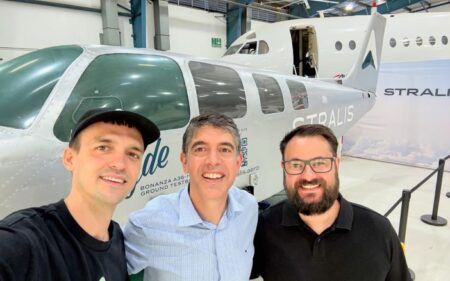Aircraft electronics and other electrically-powered equipment must be tested under extreme power conditions to ensure it will operate reliably once in the air. In the military world, MIL-STD-704 (now up to rev. F), ‘Aircraft Electric Power Characteristics’, establishes the requirements and characteristics of aircraft electric power.
The standard is not only used by the US military and military contractors, but has also been adopted, either directly or indirectly, worldwide. For example, the Chinese standard, GJB 181, ‘Characteristics of aircraft electrical power supplies and requirements for utilization equipment,’ is largely based on MIL-STD-704.
MIL-STD-704 actually defines the power characteristics of an aircraft electric power system, not the test requirements. Section 5.2, for example, describes AC power characteristics and says: “AC systems shall provide electrical power using single-phase or three-phase wire-connected grounded neutral systems. The voltage waveform shall be a sine wave with a nominal voltage of 115/200V and a nominal frequency of 400Hz.”
It also describes three alternative power systems, including a variable frequency system, a double-voltage system and a single-phase, 60Hz system. Section 5.2 goes on to describe the phase sequence for three-phase systems, normal operation, abnormal operation, and emergency operation characteristics. A series of tables lists the specifications.
Even though we call the tests performed to ensure that equipment will perform properly on board an aircraft ‘MIL-STD-704 tests’, the standard does not describe any tests. For guidance on testing, there is a series of eight handbooks that specifies tests for different types of input power, titled MIL-HDBK-704. These guidance documents, including MIL-STD-704 (revisions A through F) are available online at EverySpec.Com.
The test specified in the MIL-HDBKs is designed to ensure that airborne utilization equipment, which is defined as equipment that receives power from the aircraft’s electric power system, is compatible with the power system. To run these tests, a sophisticated power source is essential to simulate various power conditions. In addition, you also need whatever equipment is required to monitor the unit under test (UUT) while running the test.
AMETEK Programmable Power has provided test equipment for compliance tests for airborne utilization equipment for decades. Its test equipment systems cover the latest versions of MIL-STD-704 to make it more effective and easier to use. Its MIL-STD-704 test solutions are in use by customers in the USA and all over the world.
Rev. F doesn’t negate earlier versions
Although the latest version of MIL-STD-704 is rev. F, it doesn’t invalidate previous versions of the standard. The reason for this is that aircraft platforms tend to have a long life, and the power systems in those aircraft may be designed to comply with an earlier version of MIL-STD-704. When testing the utilization equipment for a particular platform then, it’s imperative that you know what revision of MIL-STD-704 the aircraft platform was designed to comply with.
The early versions of MIL-STD-704 specified the requirements for fewer types of power systems than the later revisions. Rev. A, for example, described the requirements for only three aircraft electric power systems: three-phase 115V/400Hz AC; single phase 115V/400Hz AC for devices requiring less than 500VA; and 28V DC. In rev. B, the authors added requirements for the 270V power system.
In rev. F, there are specifications for seven different power systems. In addition to the four already mentioned, rev. F includes specifications the following aircraft electric power systems: single-phase, 115V/360-800Hz various frequency; three phase 115V/360-800Hz various frequency; and single-phase 115V/60Hz to power commercial, off-the-shelf (COTS) equipment.
Because utilization equipment may have to comply with earlier versions of MIL-STD-704, AMETEK Programmable Power’s test solutions allow users to select the appropriate version of the specification when setting up the test.
MIL-HDBK-704-1 through MIL-HDBK-704-8 specify the acronyms used for the seven power groups. These are:
- SAC (single phase 115V/400Hz),
- TAC (three phase 115V/400Hz),
- SVF (single phase 115V various frequency),
- TVF (three phase 115V various frequency),
- SXF (single phase 115V/60Hz),
- HDC (270V DC), and
- LDC (28V DC).
Once these have been selected, the power source will supply power that simulates the various operating conditions as specified in MIL-STD-704. These include normal, transfer, abnormal, emergency, electric starting and power failure conditions. When subjected to these power conditions, the utilization equipment is expected to operate normally and perform to specifications.
MIL-HDBK-704-3 specifies AC tests
MIL-HDBK-704-3 provides guidance for testing utilization equipment that requires three-phase, 400Hz, 115 V AC power. As shown in Table 1, it specifies 18 different test methods:
- Test Methods TAC 101 – 110 describe tests under normal operating conditions.
- Test Method TAC 201 describes a test under transfer conditions.
- Test Methods TAC 301 to 303 describe tests under abnormal conditions.
- Test Method TAC 401 describes a test under emergency conditions.
- Test Methods TAC 601 to 603 describe tests under power failure condition.
MIL-HDBK-704-3 does not specify any tests for the electric starting condition. This condition mainly effects the DC power bus, and AC utilization equipment is not normally affected by this operating condition.
For every test method, MIL-HDBK-704-3 defines a detailed test procedure. Test Method TAC 109, ‘Normal Voltage Transients’, for example, specifies:
- Overvoltage transients, which consist of step changes from 115 V nominal to 140 V, 160 V, and 180 V with durations of varying length.
- Undervoltage transients, which consist of step changes from 115 V to 80 V and 90 V with durations of varying lengths.
- Combined transients, which consist of step changes from 115 V nominal to 80 V and 180 V with durations of 10 ms.
- Repetitive normal voltage transients, which consist of a step change from 115V to 90V, a ramp-up to 140V, and a ramp down to 115V.
The AMETEK Programmable Power MIL-STD-704 test software supports this test method, as well as other MIL-HDBK test methods. There is no need for additional programming. The complete test process can be accomplished by clicking on the tests you wish to perform.
To perform Test Method 106, ‘Voltage Distortion Spectrum’, you will need additional instrumentation. MIL-STD-704 defines the distortion spectrum from 10Hz through 50kHz, but MIL-HDBK-704 defines the distortion voltages at eight individual frequencies: 50Hz, 100Hz, 500Hz, 1kHz, 2kHz, 3kHz, 5kHz and 10kHz. During the test, the output distortion voltage from the test instrument should start from the first frequency and step through the others one by one. During the process, it should not exceed the voltage distortion spectrum limits.
Programmable power supplies generally cannot do this, so you will need to use an external variable frequency power source to generate the required distortion voltage. You can then superimpose this distortion onto the nominal stable output from the AC source.
MIL-HDBK-704-8 specifies 28V DC tests
MIL-HDBK-704-8 provides guidance for testing utilization equipment that requires 28V DC power. As shown in Table 2, it specifies 12 different test methods:
- Test Methods 101 – 105 describe tests under normal operating conditions.
- Test Method 201 describes tests under transfer conditions.
- Test Methods 301 and 302 describe tests under abnormal conditions.
- Test Method 401 describes a test under emergency conditions.
- Test Method 501 describes a test under starting conditions.
- Test Methods 601 and 602 describe tests under power failure condition.
Like MIL-HDBK-704-3, MIL-HDBK-704-8 defines detailed test procedures. It is important to note that although these are DC power tests, many test methods require a fast voltage slew rate. For example, Test Method LDC 105, ‘Normal Voltage Transients’, requires that the voltage change from the steady state lever to the transient level in a millisecond or less.
Test Method LDC 201, ‘Power Interrupt’, calls for the test voltage to go from the steady state level to 0V and from 0V back to the steady state level in 0.25ms or less. These requirements normally exceed the capabilities of most DC power supplies on the market today, but AMETEK Programmable Power’s AC/DC power sources, when set to work in DC mode, easily meet this specification.
Test Methods LDC 103 (Voltage Distortion Spectrum) and LDC 104 (Total Ripple) require additional instrumentation for the same reason that Test Method SAC 106 does. This instrumentation is the same as that required for performing Test Method SAC 106.
GJB181 sets the standard in China
In China, the standard that aircraft equipment manufacturers use to test their equipment is GJB 181, ‘Characteristics of aircraft electrical power supplies and requirements for utilization equipment’. While there are some differences, it is largely based on MIL-STD-704.
Like MIL-STD-704, GJB181 has been revised several times. GJB181-86 is equivalent to MIL-STD-704A. GJB181A-2003 corresponds to MIL-STD-704E, and GJB181B-2012 corresponds to MIL-STD-704F.
GJB181 does not, however, provide any guidance as to how to perform the tests.
There is no Chinese equivalent to the MIL-HDBK-704 series. Because the Chinese standard is so similar to the US standard, though, MIL-HDBK-704-1 through MIL-HDBK-704-8 can also provide guidance for GJB181 tests. As the Chinese say, stones from other hills may serve to polish the jade of this one.
For example, both GJB181 and MIL-STD-704 specify the power characteristics for 28V DC systems, and MIL-HDBK-704-8 describes tests for aircraft utilization equipment that are powered by 28V DC. Companies can, therefore, use the guidance provided by MIL-HDBK-704-8 when developing their GJB181 test plans for equipment that uses 28V DC.
Written by Jon Semancik, Director of Marketing, AMETEK/VTI Instruments





